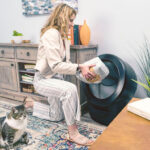Bringing flowers into your home can brighten up any space and bring a touch of nature indoors. However, if you’re a cat owner, it’s crucial to be aware that not all flowers are safe for your feline friends. Just like some plants can be toxic to cats, certain flowers can also pose a health risk if ingested. Ensuring a pet-safe environment involves choosing the right blooms.
“While any plant material can cause mild stomach upset, some plants are much more dangerous,” cautions Tina Wismer, a veterinary toxicologist and former Medical Director at the ASPCA Animal Poison Control Center. This highlights the importance of selecting flowers that are specifically non-toxic to cats. It’s also vital to remember that what’s safe for dogs isn’t always safe for cats. Lilies, for instance, are extremely dangerous for cats, potentially leading to kidney failure, while they only cause mild discomfort in dogs. Therefore, relying on “dog-friendly” plant lists isn’t sufficient when you have cats.
To help you create a beautiful and safe home for both you and your feline companion, we’ve compiled a list of cat-friendly flowers.
11 Delightful Flowers Safe for Cats
If you’re looking to add pops of color to your home without worry, these flowers are excellent choices that are considered non-toxic to cats:
-
Alstroemeria: Also known as Peruvian lilies or Lily of the Incas (though not true lilies and safe for cats), these flowers come in a variety of vibrant colors and are long-lasting in bouquets.
-
Asters: These daisy-like flowers bring a cheerful touch to any room and are safe for cats. They bloom in late summer and fall, offering beautiful seasonal color.
-
Dense Blazing Star (Liatris spicata): With their unique vertical blooms of purple or pink, blazing stars add an architectural element to floral arrangements and are safe for your feline companions.
-
Freesia: Known for their sweet fragrance and delicate, trumpet-shaped flowers, freesias are a lovely and safe option for cat households.
-
Gerbera Daisies (Gerbera jamesonii): These bright and bold daisies come in a wide array of colors and are a popular choice for bouquets and home decor, and thankfully, they are non-toxic to cats.
-
Lisianthus: Often mistaken for roses due to their delicate petals and elegant appearance, lisianthus flowers are a sophisticated and cat-safe choice.
-
Orchids: These exotic and graceful flowers are a popular houseplant and cut flower option. Many varieties of orchids are safe for cats, adding a touch of elegance without the worry of toxicity.
-
Roses: Classic and beloved, roses are a timeless choice for floral arrangements. The good news for cat owners is that roses are considered non-toxic to cats, allowing you to enjoy their beauty worry-free.
-
Snapdragons (Antirrhinum majus): These unique flowers with their dragon-mouth-like blooms add a playful texture to bouquets and are safe for cats.
-
Statice (Limonium sinuatum): Also known as sea lavender, statice flowers are known for their papery texture and long-lasting blooms. They come in various colors and are a safe choice for homes with cats.
-
Sunflowers (Helianthus angustifolius): These cheerful and sunny flowers bring a touch of summer to any space. Sunflowers are generally considered safe for cats, making them a bright and worry-free option.
Expanding Your Greenery: 20 Cat-Safe Plants
If you prefer foliage over flowers or want to add more greenery alongside your blooms, there are numerous houseplants that are safe to have around cats. Here are 20 plants to consider:
-
Areca Palm (Dypsis lutescens): Also known as butterfly palm or golden cane palm, areca palms are popular for their air-purifying qualities and feathery fronds, and they are safe for cats.
-
Bamboo (Phyllostachys aurea): Bamboo plants add a touch of zen to your home. Many types of bamboo are safe for cats, providing a stylish and non-toxic green element.
-
Basil (Ocimum basilicum): This fragrant herb is not only culinary but also safe for cats. You can grow basil indoors, adding fresh herbs and greenery to your home.
-
Boston Fern (Nephrolepis exalta bostoniensis): With their classic, lush fronds, Boston ferns are a popular choice for hanging baskets and plant stands, and they are considered non-toxic to cats.
-
Cilantro (Coriandrum sativum): Similar to basil, cilantro is a culinary herb that is also safe for cats. Growing cilantro indoors is a convenient and pet-safe option.
-
Dill (Anethum graveolens): Another herb that’s safe for cats, dill adds a delicate flavor to cooking and can be grown indoors as a cat-friendly plant.
-
Dwarf Date Palm (Phoenix acaulis): For a touch of the tropics, dwarf date palms are a smaller palm variety that is safe for cats and can thrive indoors.
-
Friendship Plant (Pilea involucrata): Known for its textured, quilted leaves, the friendship plant is an interesting and safe houseplant for cat owners.
-
Hens and Chicks (Echeveria elegans): These succulents are easy to care for and feature rosette-shaped leaves. Hens and chicks are generally considered safe for cats.
-
Lady Palm (Rhapis excelsa): Similar to areca palms, lady palms offer an elegant, fan-like foliage and are a safe palm variety for cat households.
-
Lemon Balm (Melissa officinalis): This lemony-scented herb is part of the mint family and is safe for cats. It can be grown indoors and may even repel mosquitoes.
-
Old Man Cactus (Cephalocereus senilis): With its distinctive white, hair-like spines, the old man cactus adds a unique desert vibe and is considered non-toxic to cats.
-
Painted Lady (Echeveria multicaulis): Another Echeveria succulent, the painted lady features colorful leaf edges and is safe for cats.
-
Reed Palm (Chamaedorea elegans): Also known as parlor palm, reed palms are a classic houseplant that is easy to grow and safe for cats.
-
Rosemary (Rosmarinus officinalis): This fragrant and woody herb is safe for cats and can be used in cooking. Rosemary is a drought-tolerant and aromatic addition to your indoor garden.
-
Sage (Salvia officinalis): Another culinary herb safe for cats, sage offers a slightly peppery flavor and can be grown indoors as a cat-friendly plant.
-
Shrimp Cactus (Schlumbergera russelliana): Also known as Christmas cactus or Thanksgiving cactus, shrimp cacti produce beautiful, cascading blooms and are safe for cats.
-
Spider Plant/Spider Ivy (Chlorophytum comosum): Spider plants are incredibly easy to propagate and care for, making them a popular choice. They are also non-toxic to cats and even air-purifying.
-
Venus Fly Trap (Dionaea muscipula): This carnivorous plant is fascinating and safe for cats. While it might be tempting for a curious cat to investigate, it poses no toxic threat.
-
Zebra Haworthia (Haworthia fasciata): This succulent features striking white stripes on its leaves, resembling zebra stripes. Zebra haworthia is a low-maintenance and cat-safe plant.
Important Note: Always double-check the scientific name (genus and species) of a plant to ensure accurate identification. Common names can be misleading, and some plants with similar common names might have different toxicity levels. Reputable databases like the ASPCA Pet Poison Control’s toxic and non-toxic plants list are excellent resources for verifying plant safety.
General Plant Safety for Cats: Beyond Toxicity
Even non-toxic plants can present some risks to cats. Any plant material, if ingested, can potentially cause mild gastrointestinal upset in cats. Furthermore, cut flower food, often included with bouquets, can also lead to an upset stomach if consumed by cats. Symptoms to watch for include vomiting, diarrhea, and loss of appetite. If a cat consumes a large quantity of any plant material, there’s also a risk of gastrointestinal blockage.
Vases themselves can also pose a hazard. Cats are naturally curious and may try to drink water from vases, potentially knocking over heavy or breakable vases, leading to injury.
To minimize risks, it’s always best to keep plants and flowers out of reach of your cats. Consider placing them in rooms your cat doesn’t have unsupervised access to or using hanging planters.
What to Do If You Suspect Your Cat Has Eaten a Poisonous Plant
If you suspect your cat has ingested a potentially toxic plant, immediate action is crucial. Contact your veterinarian, an emergency vet clinic, or a pet poison helpline immediately. The Pet Poison Helpline (855-764-7661) and the ASPCA Animal Poison Control Center (888-426-4435) are valuable resources. Don’t hesitate to call even if you are unsure if the plant is toxic; prompt treatment can significantly improve outcomes and potentially save your cat’s life and reduce treatment costs.
The Safest Plant of All: Cat Grass
For cats who enjoy nibbling on greenery, cat grass is the safest and most beneficial option. Cat grass is typically a mix of grasses like oat, wheat, barley, alfalfa, and rye grass, specifically grown for cats. It’s readily available at pet stores and provides a safe outlet for a cat’s natural urge to chew on plants.
Common Questions About Cat-Safe Flowers and Plants
Are roses poisonous to cats?
No, roses are not toxic to cats. However, be mindful of thorns, which can cause injury if they become embedded in a cat’s skin or mouth.
Are orchids poisonous to cats?
No, orchids are also considered non-toxic to cats, making them a safe and elegant floral choice.
Is it safe for cats to eat catnip plants?
Catnip is safe for cats in moderation. However, excessive consumption can lead to mild gastrointestinal upset, over-sedation, or over-stimulation in some cats. Consult your veterinarian for advice on catnip use for your cat.
By choosing cat-friendly flowers and plants and taking some basic safety precautions, you can create a beautiful, green home that is also a safe haven for your feline companion.


